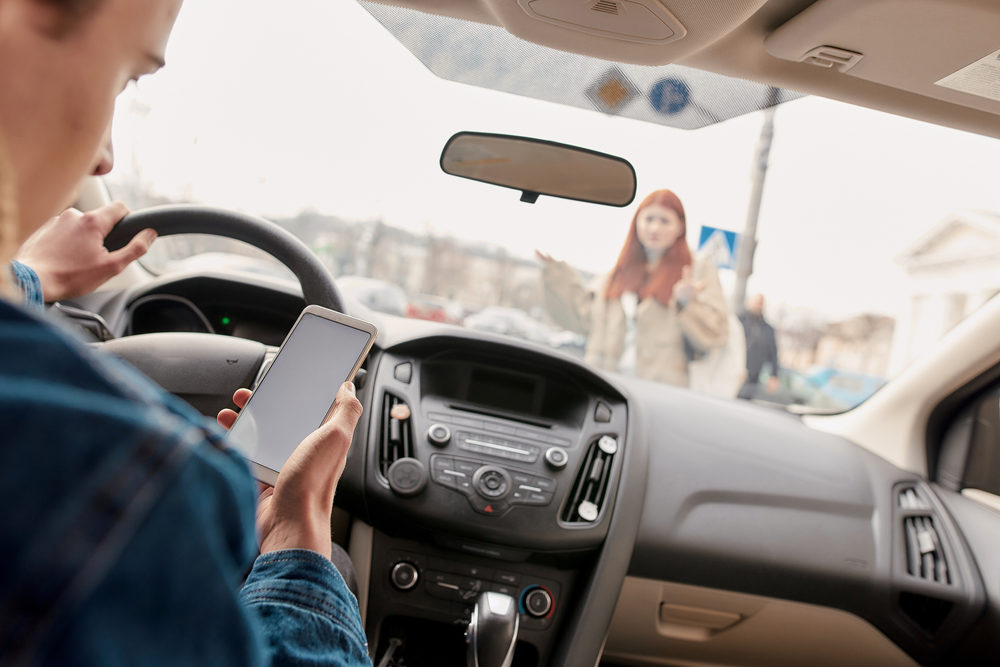
Distracted driving is the number one cause of fatal car accidents in the United States. Approximately eight people die every day in highly preventable crashes because drivers focus on something other than the road.
Examples of distracted driving include eating or drinking, reading or watching something, putting on makeup, having conversations with your passengers, and, more than anything, using your cell phone. A 2016 survey by the National Safety Council (NSC) revealed that 50% of surveyed drivers made or answered phone calls with hands-free devices, 32% read or sent a text message, 20% surfed the Internet, and 14% even watched a movie/video or participated in a video chat on their phones. Distracted drivers are also more likely than any other type – including drunk drivers – to fail to stop at an intersection, speed and have a near-collision.
Texting while driving has been illegal in Texas since 2017, but many motorists are surprised to learn it is a fineable offense up to $200. What is also alarming is many drivers understand the dangers of texting and driving but are confident they can text and drive safely.
Distracted driving is most prevalent among teenagers, but it is found in nearly every driver demographic, including those who drive professionally for their employer. Companies that employ a driver involved in a distracted driving accident can be drowned by the resulting costs of the accident, including lawsuits, insurance premiums, public image and damaged equipment.
Texas Distracted Driving Initiatives
Texas, which currently has the highest number of fatal car crashes, has come up with several distracted driving prevention initiatives. The Heads up, Texas statewide public awareness campaign from the Texas Department of Transportation educates drivers about the laws and dangers of distracted driving via social media and social media influencers, and even created an augmented reality game called “Dart Those Distractions.” The interactive game can be played on any tablet or smartphone and involves throwing darts at balloons that symbolize different distractions. “Heads up, Texas” is part of a larger campaign called #EndTheStreakTX that encourages drivers to make safer choices behind the wheel. It asks all Texans to commit to safe driving in an effort to reduce fatalities. Texas has not had a day without a death on the road since 2000.
National Distracted Driving Safety Efforts
Nationwide, many states have added or updated distracted driving laws. The National Highway Traffic Safety Administration’s (NHTSA) efforts include increased police enforcement of the distracted driving laws and awareness of the problem via radio and news media. Some states use the graduated driver licensing (GDL) system to help new drivers gain experience by granting driving privileges in five stages, including restricting the number of young passengers a teenager can transport. Other state-level efforts include rumble strips on highways to alert drivers that they are about to veer off the road.
Federal regulations have been enacted as well, including a 2009 executive order by President Obama banning all federal workers from texting while driving. Department of Transportation agencies, including The Federal Motor Carrier Safety Administration (FMCSA) and the Federal Railroad Administration, also prohibit employees from texting while operating a commercial motor vehicle (CMV) or being engaged in rail operations.
The NHTSA consistently releases active campaigns and public service announcements, most recently a campaign for April’s Distracted Driving Awareness month called “U Drive. U Text. U Pay” campaign. The CDC also developed one called “Parents Are the Key” to help parents and other adults keep teen drivers safe.
How Individuals Can Kick Distracted Driving to the Curb
But what can you personally do as a driver, passenger, or parent to help improve distracted driver safety? If you are a driver, simply refrain from multitasking while driving. Focus on the road. There are even apps designed to help you avoid direct contact with your phone.
If you are a passenger, don’t be afraid to speak up if a driver is unsafe. You can also offer to navigate or help with other tasks.
Parents can help by learning their state’s laws on distracted driving and imposing their own rules for the privilege of driving. You can set an excellent example while practicing safe driving with kids in the car. You can share stories or even YouTube videos about the sometimes gruesome consequences of texting on the road.
Here are some other ways to minimize your risk of driving while distracted:
- Don’t eat/drink/use your phone
- Avoid complicated tasks such as programming a GPS
- Make adjustments for comfortable driving before pulling away
- Pull over in a safe place if you must check a text or do something other than driving
- Never drive while drowsy: it can be more harmful than alcohol
If you or someone you know has been a victim of a distracted driving accident, attaining competent car accident legal representation is key. The dedicated team at The Cochran Firm Texas is experienced in handling all types of car accident cases. Our firm will work with you to make sure you are sufficiently compensated for any damages or injuries. For more information or a free consultation, call 1-800-The Firm (800-843-3476), contact us online, or use our online chat now.

At Cochran Texas, we understand that needing legal help can be scary. It doesn’t have to be. We are a trusted leader in the legal profession and in our community. We know you are more than a case number. We get to know you as a person. This allows us to offer a balanced and thoughtful approach to giving you the best possible legal representation. Our mission is to protect the legal rights of ALL people in our community. No matter your race, gender, background or income level you have a right to skilled legal help. Call us at 800-843-3476.














Comments for this article are closed.